After four visits to Berlin, three over the past seven years and one when the city was famously divided into East and West, I’m still no expert on the city. I haven’t “done” many of the famous attractions which you probably know – the Bundestag, Museum Island, even a boat ride on the Spree. Perhaps if my relationship with Berlin were different, I would be regaling you with stories about those places today. But I’ve come to know Berlin through the eyes of my father, a native. This provides a wonderful and very different vantage point from which to embrace the city. Things feel, well, personal.
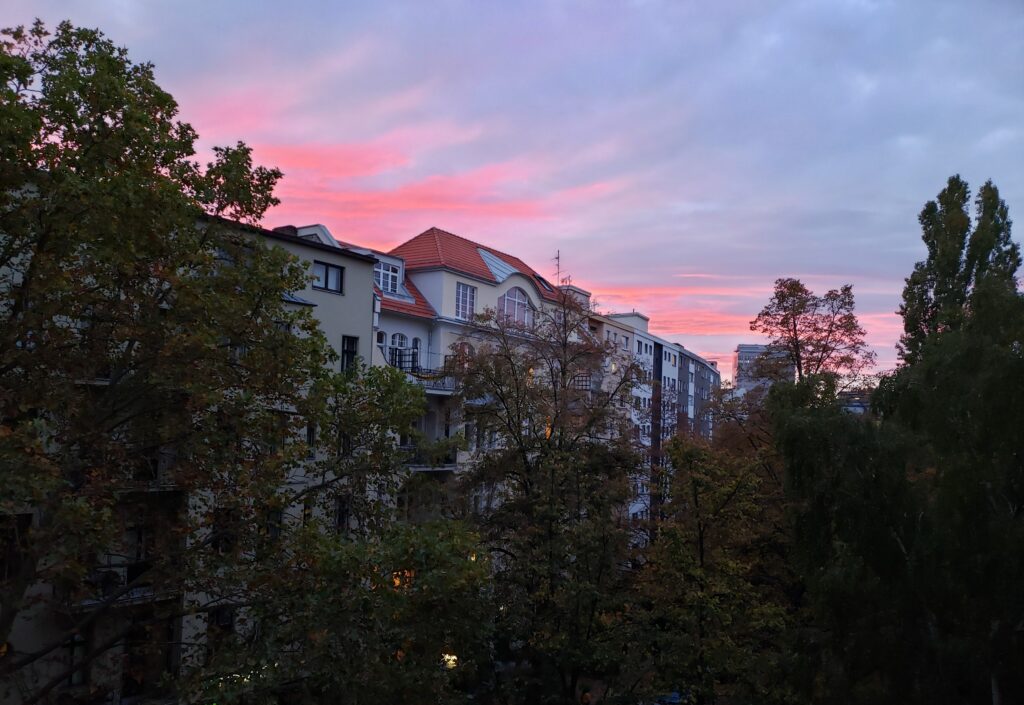
It starts with where we settle in. Not the Marriott or Steigenberger, a German hotel chain, but a simple rental apartment in the neighborhood known as Wilmersdorf. Two bedrooms, two bathrooms, eat-in kitchen and living room. The kitchen is stocked with just a few essentials and includes an all-in-one washer/dryer plus dishwasher and microwave. There is also a TV which doubles as a radio; this produces excellent classical music during nearly all of our waking (and sometimes sleeping) hours. What’s remarkable about this place is that we want for nothing despite having downsized hugely from the houses we normally live in. A great reminder about how very happy and free one can feel with less.
Wilmersdorf is agreeable for many reasons. We gaze out our picture window at a splendid tree which commands our attention.
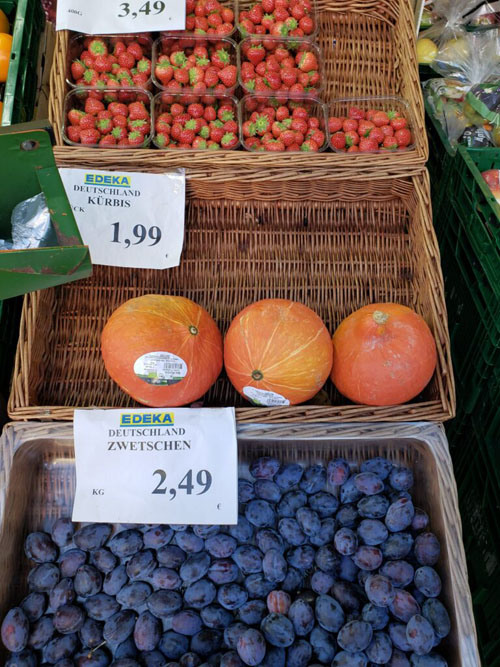
We walk to a wide array of ethnic restaurants in under 10 minutes. Directly across the street is the corner store “Nah und Gut”. (Near and Good.) A tiny place by American standards, it offers all that we need and more. This includes freshly-baked rolls and croissants, Spanish persimmons, plump figs, pre-cooked, roasted duck (or goose), rice pudding, sweet holiday specialities like Lebkuchen, Stollen and my Berlin Grandma Lotte’s favorite “Dominosteine” (a layered confection featuring marzipan, gingerbread dough, and jam, blanketed in chocolate).
But for those days when we really want to gild the culinary lily, there is KaDeWe, an 8 minute walk away.
KaDeWe, short for Kaufhof des Westens (store of the West), is a Berlin institution dating from 1907. It is Europe’s largest department store, featuring high end goods.
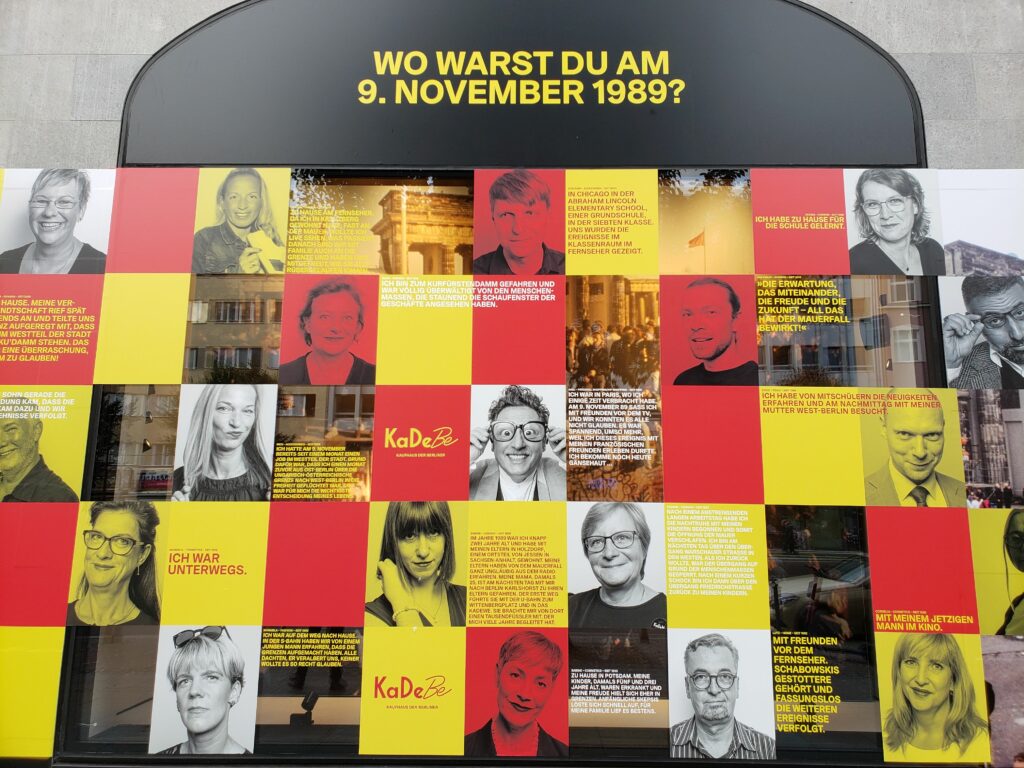
KaDeWe attracts a wide array of visitors, shoppers, and gawkers alike. As I waited patiently to cross the street to reach it one morning – no jaywalking in Berlin, please! – an Aston Martin pulled up, parked illegally on the street corner, and ejected Gucci loafers, in which stood a dashing gentleman. His female companion was buried under an extravagant fur-lined coat. Off to Kadewe for a bit of Saturday shopping…..
When you enter the grand building on the street level, you have many choices. You could amble among the diamond-studded watches or costly perfumes.
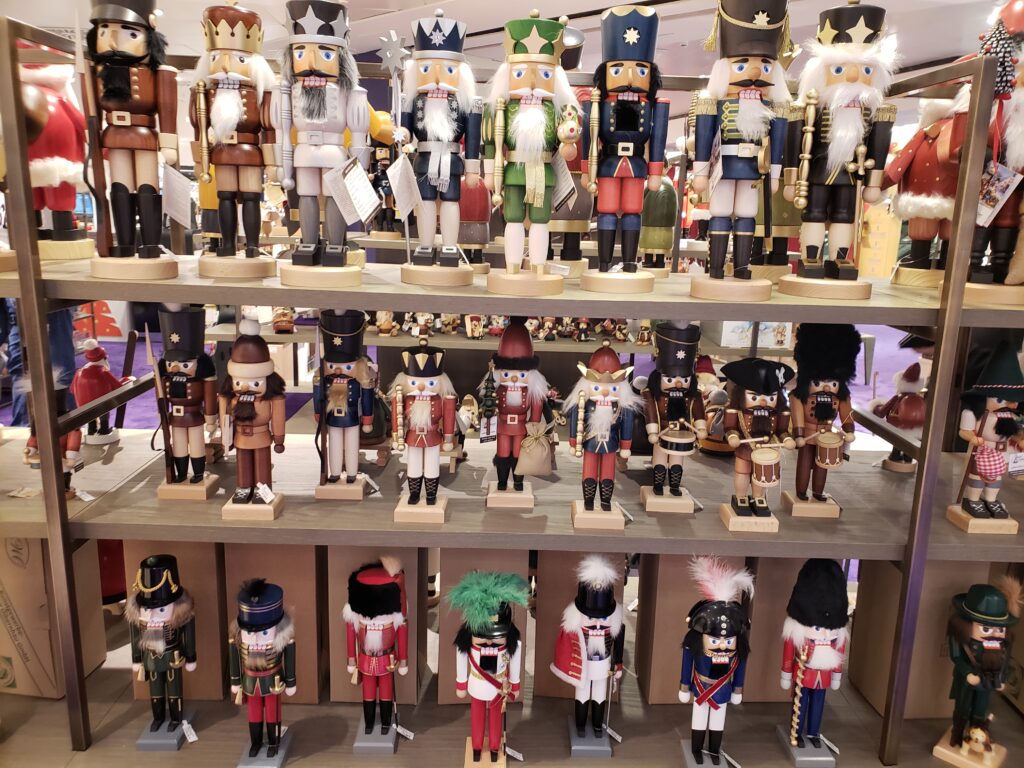
You could ascend directly to the restaurant on the top floor. Or if it’s mid-October through December, you could check out the museum-like display of Christmas wonderment. But for me, all the action happens on the sixth floor. This is where Berlin’s finest food hall is to be found. The highest quality culinary selections from around the world – including pastries from Lenôtre in Paris – are laid out daily in tantalizing displays.
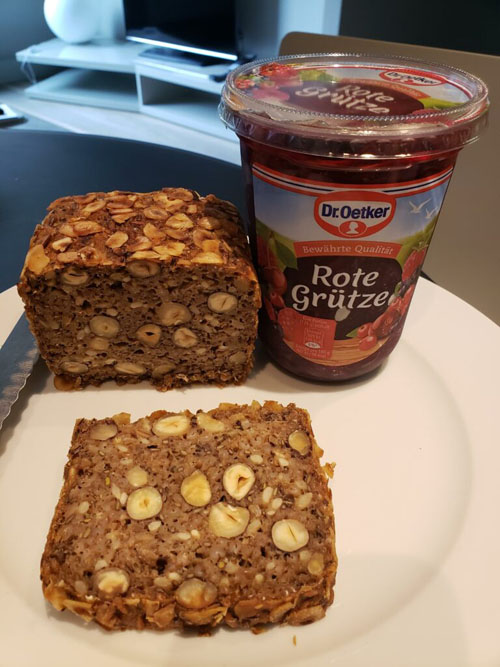
Fresh breads, including my favorite- a dense loaf studded with whole hazelnuts, still-warm rolls with grated carrot and pumpkin seeds, Schnecke (“Snails” aka Pain aux Raisins), Berliners (royalty of the donut family), tarts, tortes…it goes on and on. The same is true in other departments; cheese, meat, tea, candy, etc. Perfectly positioned amidst all these edible delights are mini bar areas designed for instant gratification! It’s all so easy just to sit and enjoy a glass of Champagne, or a sandwich that tastes nothing like any you’ve ever known, or a bowl of fresh pasta, or coffee and cake. Meine Meinung nach (that’s German for IMHO), the 6th floor of KaDeWe rivals – no, it exceeds – many of Berlin’s top tourist attractions!
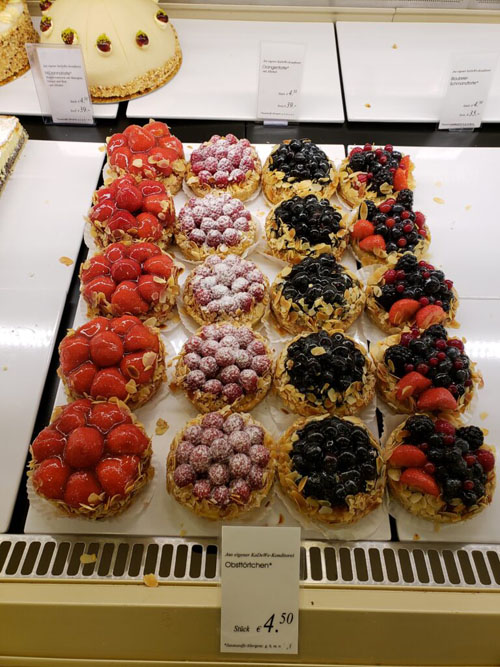
Berlin attracts a diverse population which plays out nicely in terms of restaurant options. Over the course of our 8 days, we dined at places featuring Turkish, Italian, Austrian, Swiss, Silesian, and deeply German cuisines. We had plans also for Georgian and Lebanese food, as well as the Russian place right across the street, but wound up carting home so many leftovers that we had to table those restaurants for next year. All these eateries are within a short walk from “home” but our neighborhood isn’t exceptional in this regard. On the contrary, Wilmersdorf is relatively sleepy compared to other parts of town like Neukölln or Prenzlauer Berg, but the same preponderance of interesting dining options can be found all over Berlin.
When you walk into Hasir, “our” neighborhood Turkish restaurant, you are greeted by the kerchiefed double of Mr. Clean who rules the clay oven.
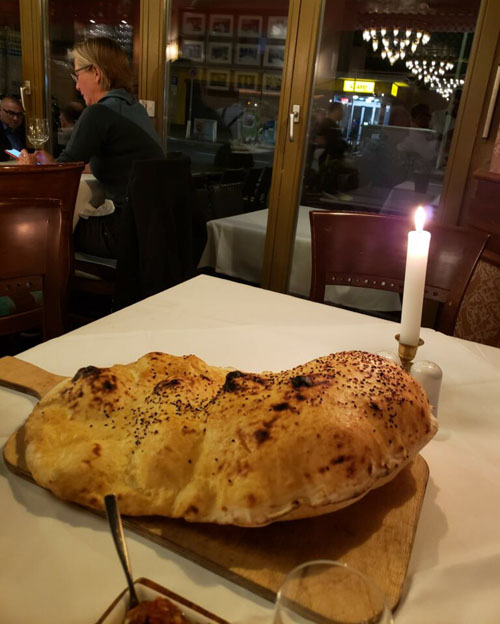
This enormous device produces a piping hot billowy bread which metamorphosizes into perfection when a rainfall of black and white seeds cascades on top. Served with a tray of tasty dips and a glass of licorice-y Raki, this traditionally kicks off our Berlin welcome meal.
At Gasthaus Krombach, a cozy, traditional “Berlin kitchen”, Dad orders his favorite meal –Linsensuppe (lentil soup), Königsberger Klopse with potatoes, and Rote Grütze, a berry compote.
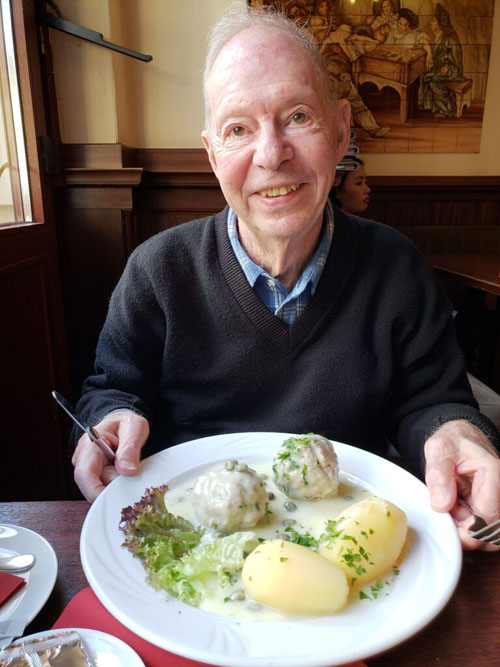
Königsberger Klopse are named for Königsberg, the town which served as the capital of the Prussian empire in the 1500’s and 1600’s, and is now known as Kaliningrad (Russia). They are essentially boiled meatballs (don’t judge – yet!) from a mix of veal/beef and sometimes pork, but with a unique sauce which contains capers, lemon juice, flour, egg yolk, cream and other ingredients (umm…anchovies or sardines which I do NOT employ when I cook this dish!) to render it piquant and perfect with the meatballs. As for the Rote Grütze (red berry pudding), this is standard summer fare in my kitchen. Served with a vanilla sauce, this tart and tasty fruit finale is a winner. It also doubles as a great mix-in with yogurt, or on top of waffles or pancakes.
Now where was I? Oh yes, the restaurants! Ottenthal, my favorite Berlin dinner spot, serves up traditional Austrian fare with a modern twist. Piping hot, crispy Wienerschnitzel is as light as air and bigger than your head.
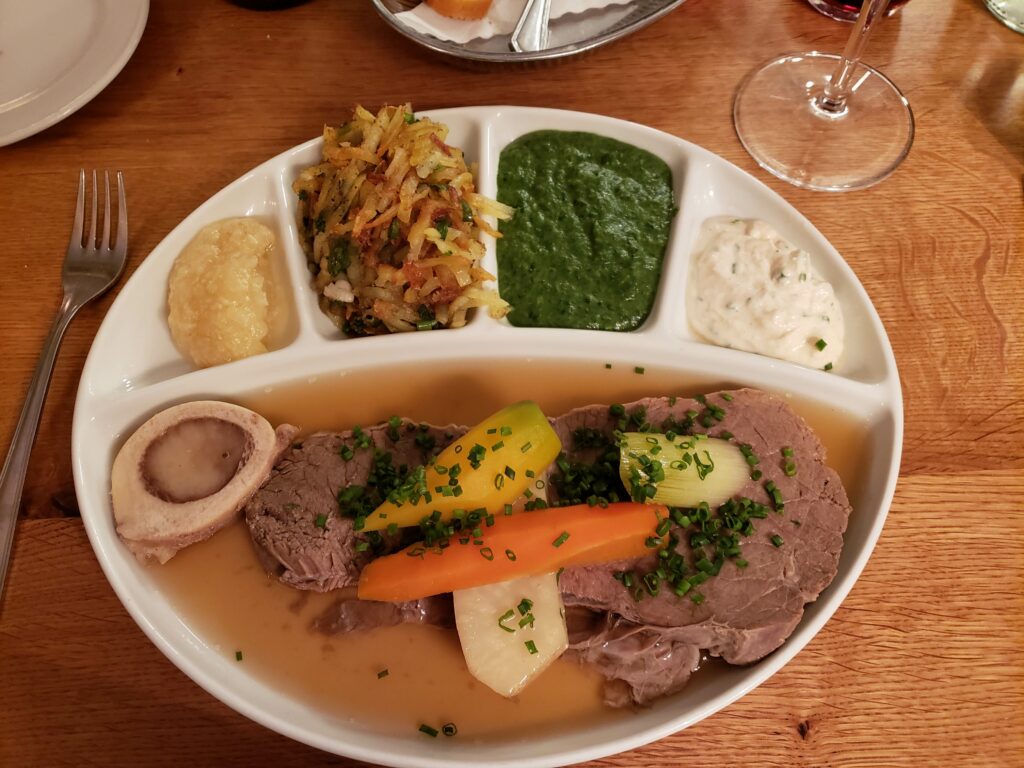
On this occasion, I break with tradition and order Tafelspitz, a boiled beef dish that tastes a million times better than it sounds and is accompanied by an array of “Beilage” or sides. After the entree, you must order Sachertorte, which rivals any in Vienna; trust me, I’ve done the research on this! Although you won’t go wrong with Berlin’s favorite cake, the Baumkuchen or Tree Cake which features 15-20 layers (!) each representing a ring of a tree trunk. This is such a complicated cake to make that it’s required baking for any German pastry chef to earn the title of “Meister” (Master) and is referred to as ” “Der Konig der Kuchen” (“The King of Cakes”) in Germany.
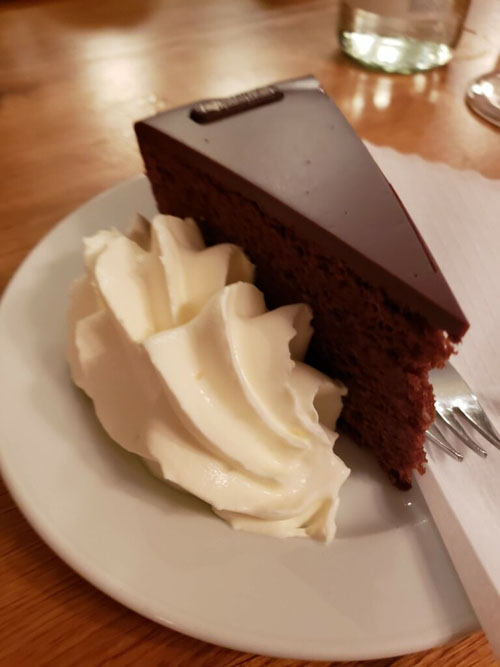
Cacio e Pepe, the tiny Italian place on the next block, has 4.7 stars and served up a mouth-watering fresh tagliatelle with roasted cherry tomatoes, zucchini, and chicken – at prices considerably less than back home. People in this part of Europe take food seriously and demand the highest quality both in terms of local ingredients at grocery stores as well as in restaurants. And they get it.
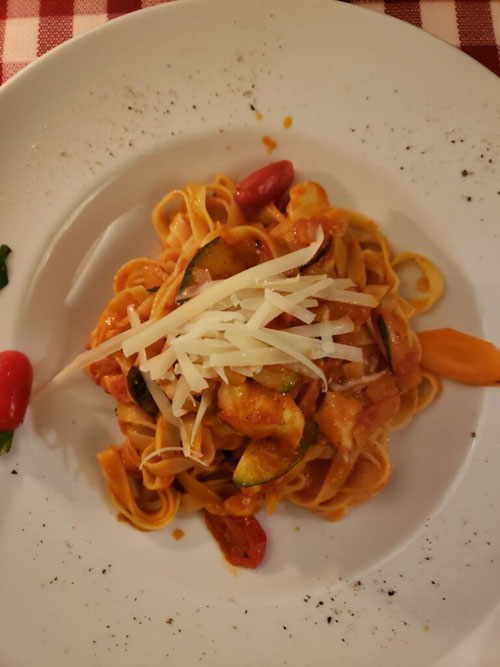
One day we travel by train about 2 hours west to Hannover, known as “the Garden City”, in Lower Saxony. Dear friends invite us to a special lunch at the Parkhaus restaurant by Die alte Mühle (Old Mill).
The Old Mill was built in 1580 and had five prior addresses before finally being installed at this site in 1938. On this day, autumn is in full swing at the site of the Old Mill in Hermann-Löns-Park. (You haven’t heard of Hermann Löns? He was a locally famous poet, journalist and writer of songs who celebrated the German moors which are plentiful in this region.)
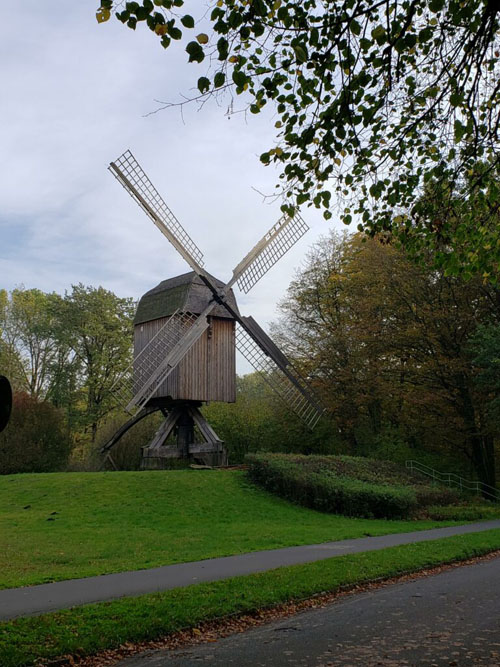
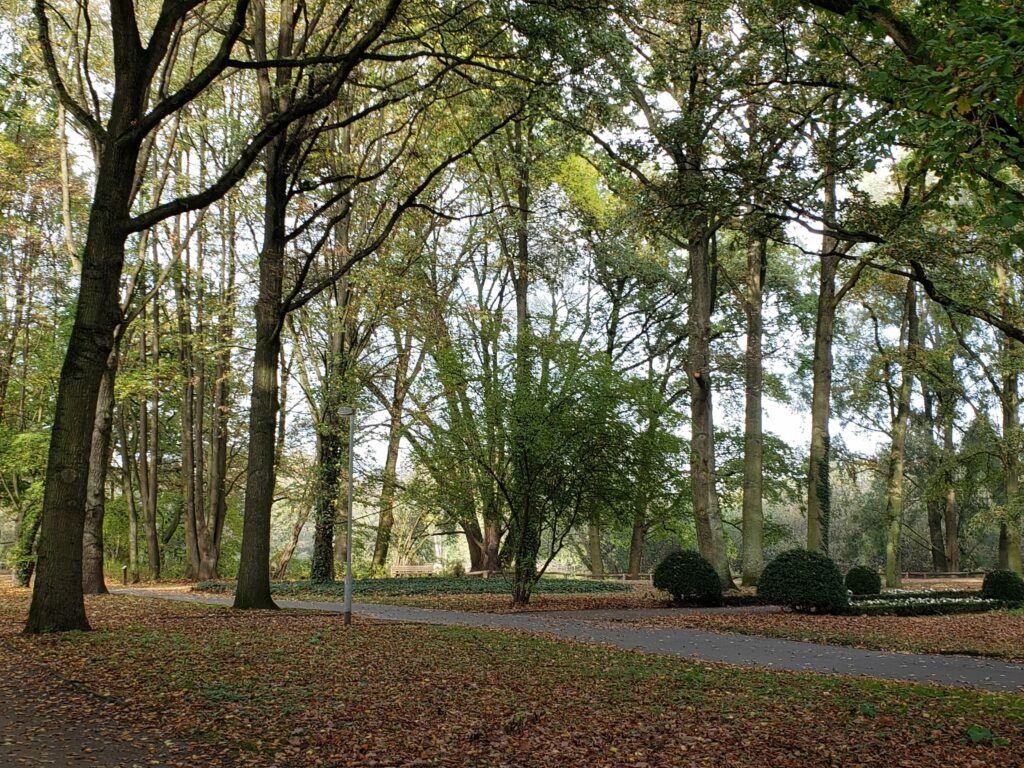
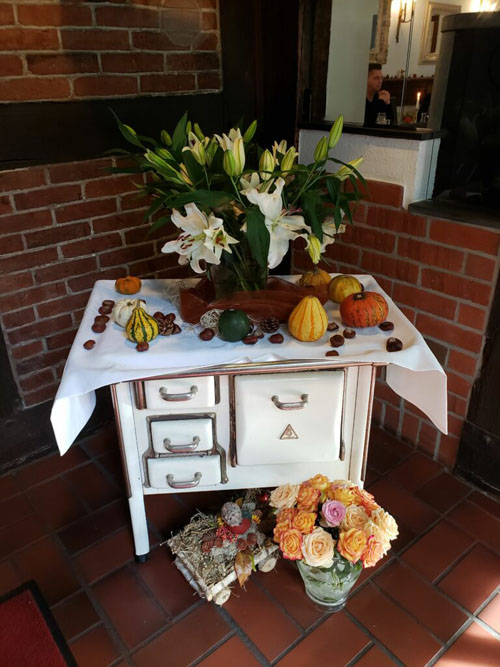
Ducks glide across a mirror pond. Rust-colored trees dispatch their leaves which flutter to the earth below.
It’s all so still and lovely and grand; you can hardly believe one of Europe’s leading trade fair locations is a few miles away.
Meanwhile, inside the Parkhaus restaurant, which is somehow cozy casual and elegant and gourmet all at the same time, our mouths commence watering as soon as we are seated. The menfolk are not distracted by the tableside display of the daily special – a platter of four huge silver fishes which look like they might have still been swimming an hour ago. Instead, they know to order the Roast Duck with red cabbage, potato croquettes and baked apple filled with stewed dark cherries.
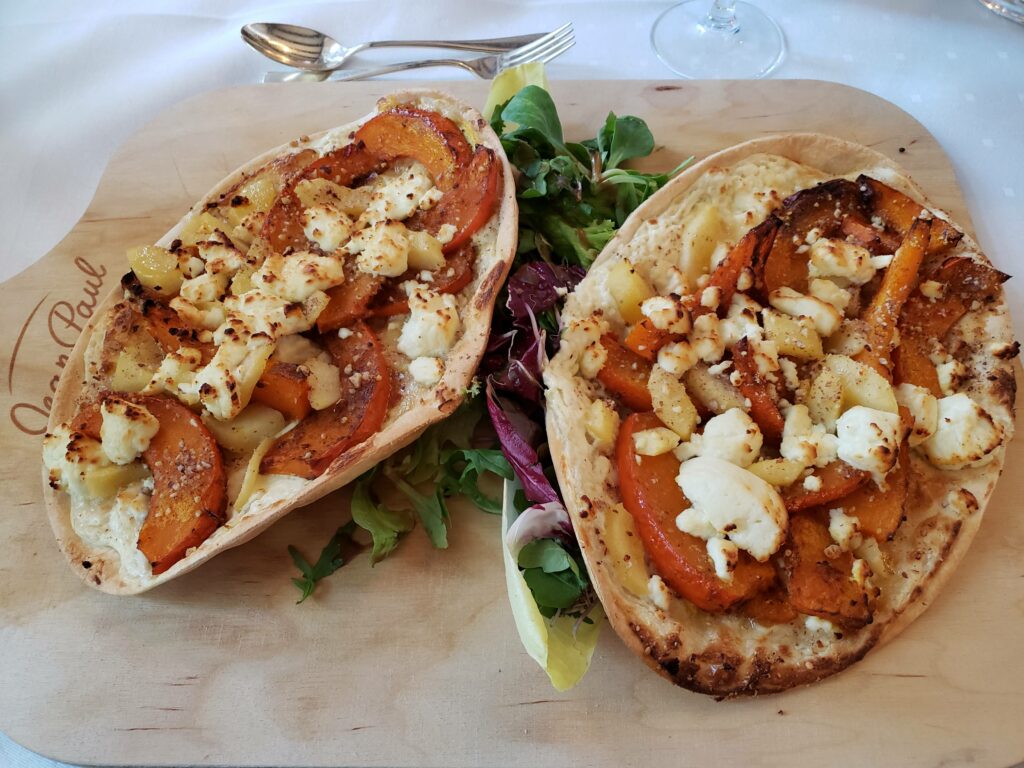
My piadines, of which I could barely consume half, were truly “lecker” (yummy) – topped with pumpkin, fresh sheep’s cheese and roasted apples.
It may seem by now that all we did on this trip was eat. Well, yes, but….
We also had a great dose of culture (thanks to Yo Yo Ma and Daniel Barenboim) at the Berlin Philharmonie, also known as the “Pregnant Oyster” for its unique shape.
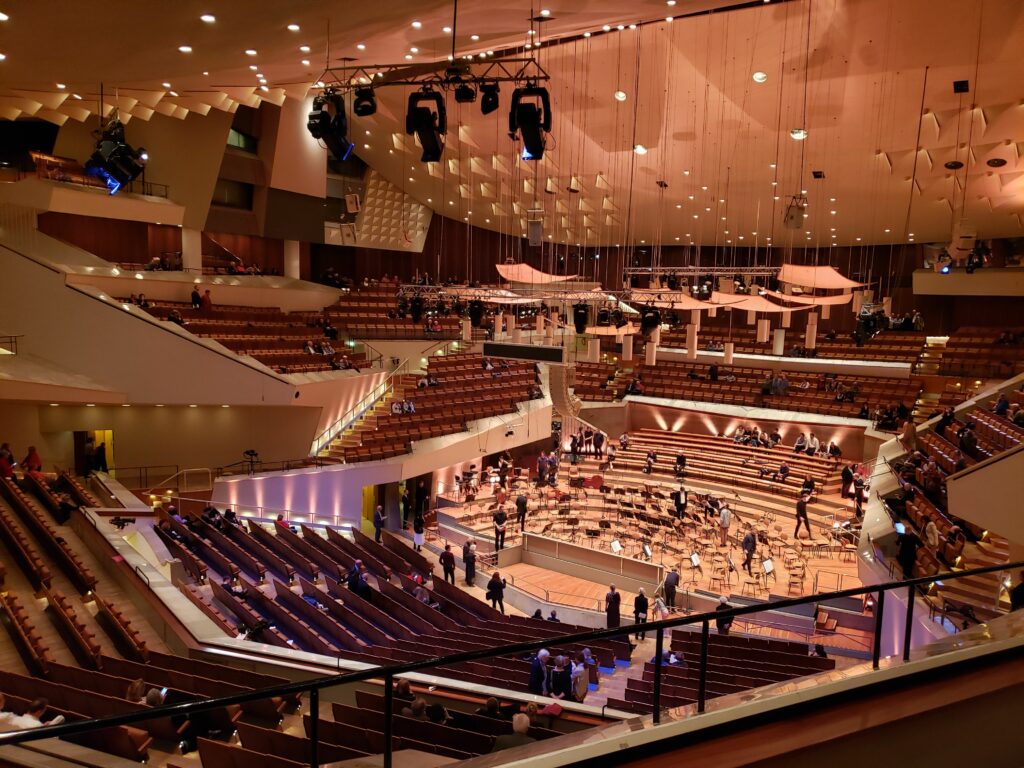
We made the pilgrimage to the largest zoo in the world which first opened in 1844. Here we visit the comical peccaries, exotic birds, and Katjuscha, a 35 year old polar bear who has defied all odds and lived with heart disease for decades.
We walked Berlin’s finest street, the Kurfurstendamm (known locally as the Kudamm) and shopped for teas, chocolates, jams and honey at Ullrich, our favorite discount store.
We visited Dad’s old neighborhood in the East. Bombed by the Russians in the 1930’s, the street on which he lived was completely destroyed, but the waters in the Märchenbrunnen, the fairy tale fountain he visited in his baby carriage, still flow.
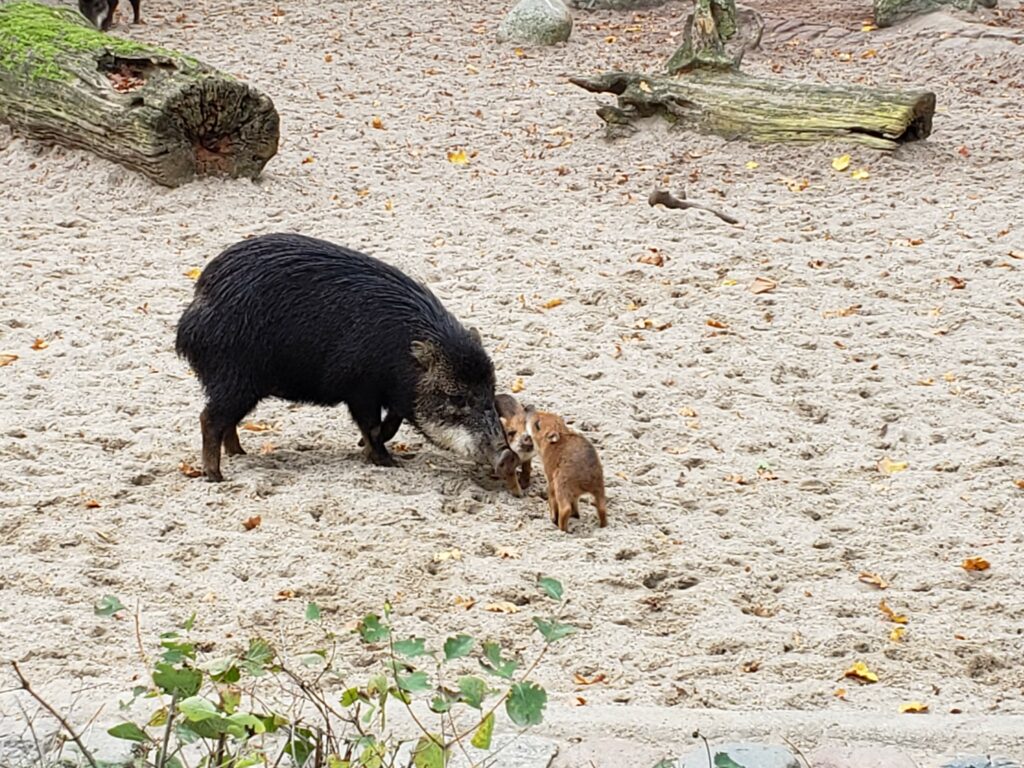
And we tooled around the Flohmarkt (flea market) at the Rathaus (no rodents, just the Town Hall), uncovering all sorts of treasures, especially books and music. Matter of fact, it was that day, chatting it up with the vendors, carting off our new treasures, and wandering one short block to an outdoor café for cappuccino and fresh apricot torte, that I felt most like a local.
Until my final night in Berlin. Dad had gifted me a cooking course, way up in the northern outskirts of the city. The four hour course – all in German – was to feature Swiss and Austrian specialties. It promised a full (a very full) menu and copious amounts of alcohol to wash it all down with.
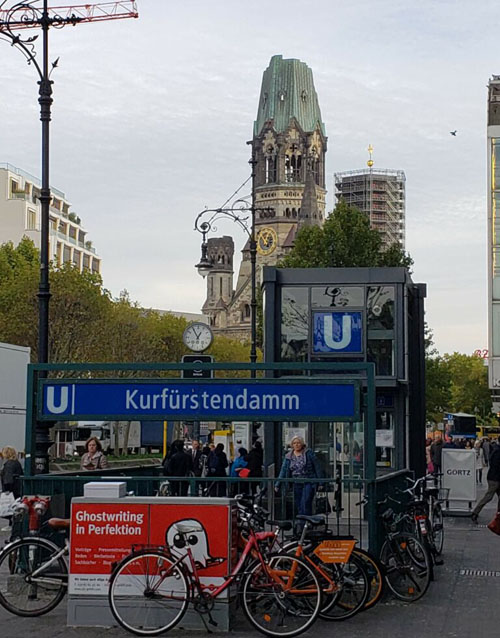
After an initial rough start where my Uber driver couldn’t find the location, I eventually discovered the spot, tucked well back from the main road. I made my way into the building. Germans are famous for their punctuality and I was pleased to note that despite getting lost, I was still 10 minutes early for class. But what was this? As I entered the room, I immediately noticed that everyone else was dressed very convincingly in Roaring 20’s attire. WTH? Did I miss an email? My heart sank. My black jeans and sweater were not going to cut it.
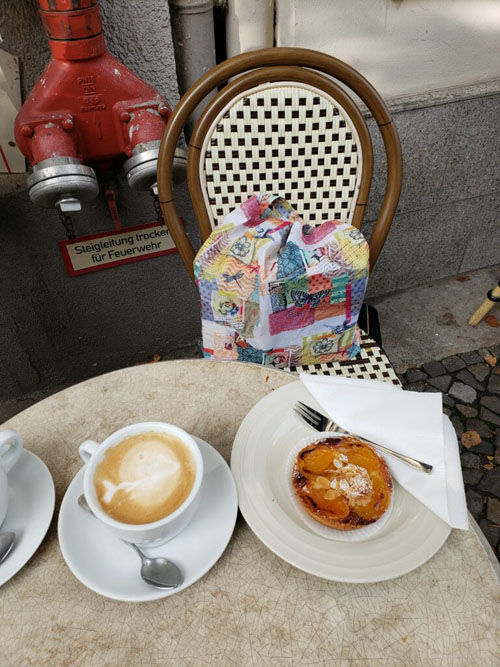
That’s when a kind and observant woman with feathery headband and long gloves appeared and suggested I try going upstairs, away from this private party on the first floor.
Unbelievably I was still the first to arrive. Our chef Robert (“Row-bert”, as pronounced in German) spoke faster than any German-speaker I have ever encountered. Despite being on the cusp of fluency, I would need ammunition. So I fortified myself with a hefty glass of Prosecco mixed with Limoncello (Row-bert’s suggestion) and a few slices of very fresh bread with delicious spreads.
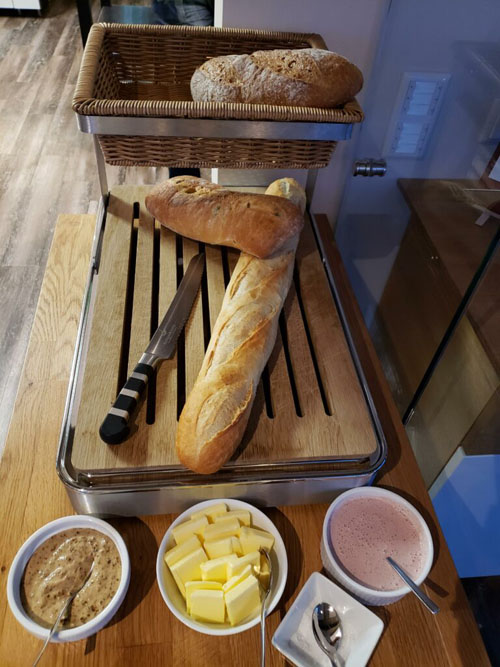
The others arrived – 3 couples, including one clad in lederhosen and dirndl out of respect for our Austrian menu, plus my friend Laurie whom I hadn’t seen in 5 years and who had literally just deplaned from Barcelona. (you can do these things when you live in Europe. Be still my beating heart).
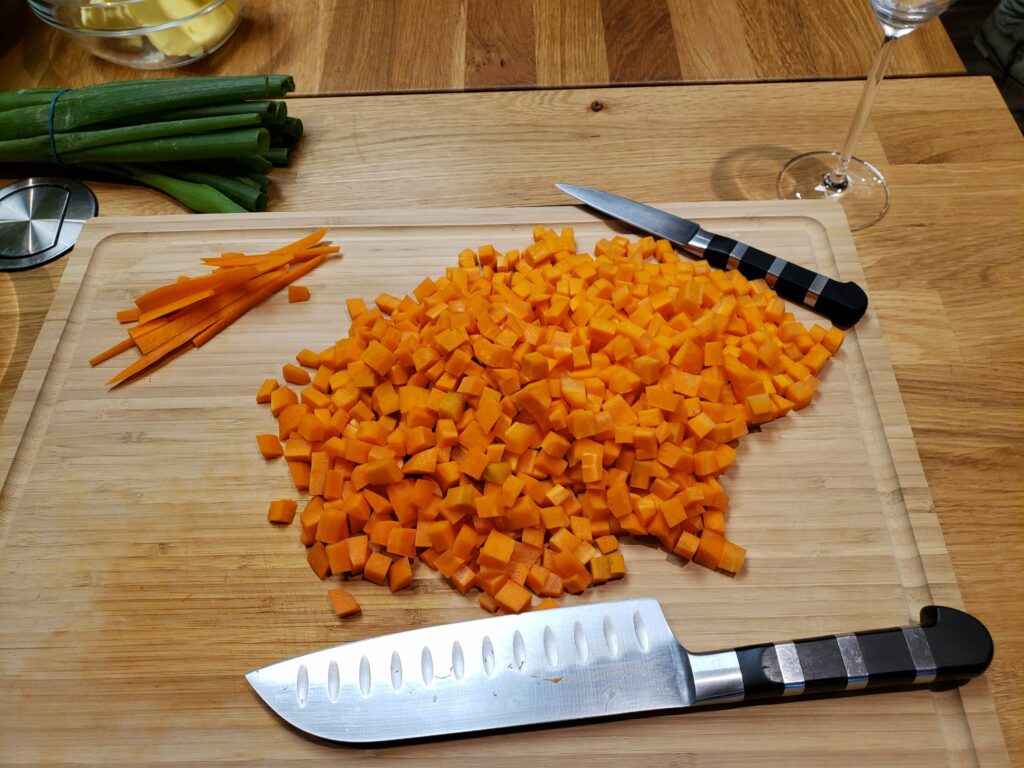
We set out doing all the meal prep – what a feast we prepared. And how much local Riesling flowed – necessary to fuel us as we chopped mountains of potatoes, bundles of carrots, and practiced plating each dish with technical precision.
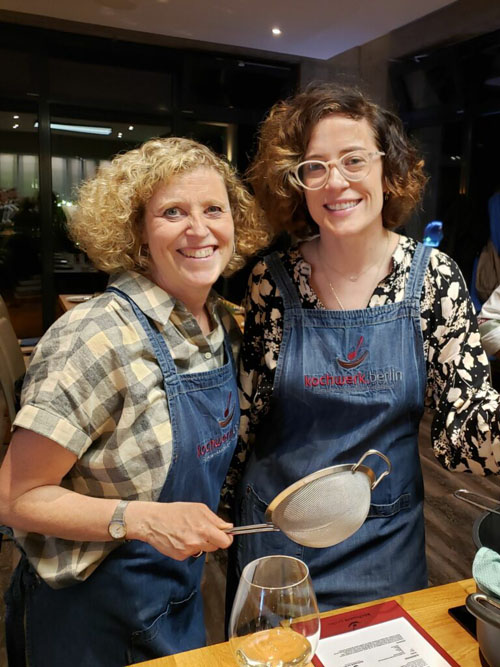
Soup with thin strips of homemade crepes, an outstanding lamb’s leaf salad with Speck (aged and salted smoked pork) and pumpkin seeds – this also served as a base for fried chicken and ham/cheese strudel.
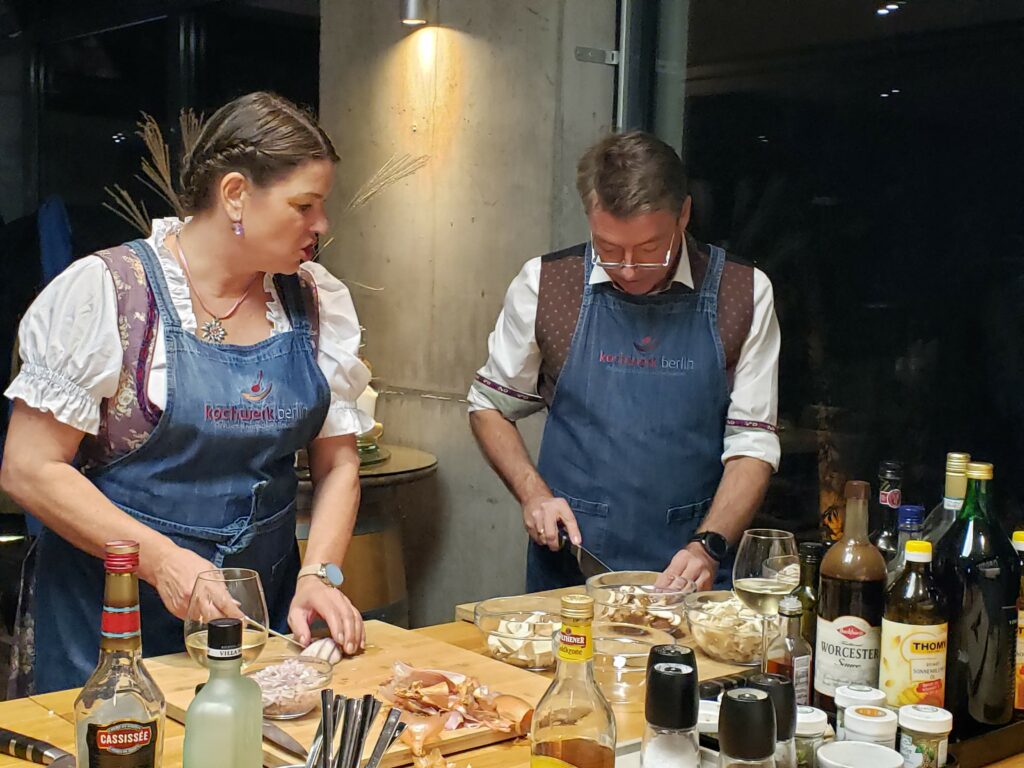
To impress your German-speaking friends, just tell them about the appetizer, aka “Nüsslisalat mit ausgelassenem Tiroler-Speck, und Kürbis Kernen dazu Back-Hendl und Steirisches Kürbis Kernol und knusprige Kase-Schinken-Strudel.
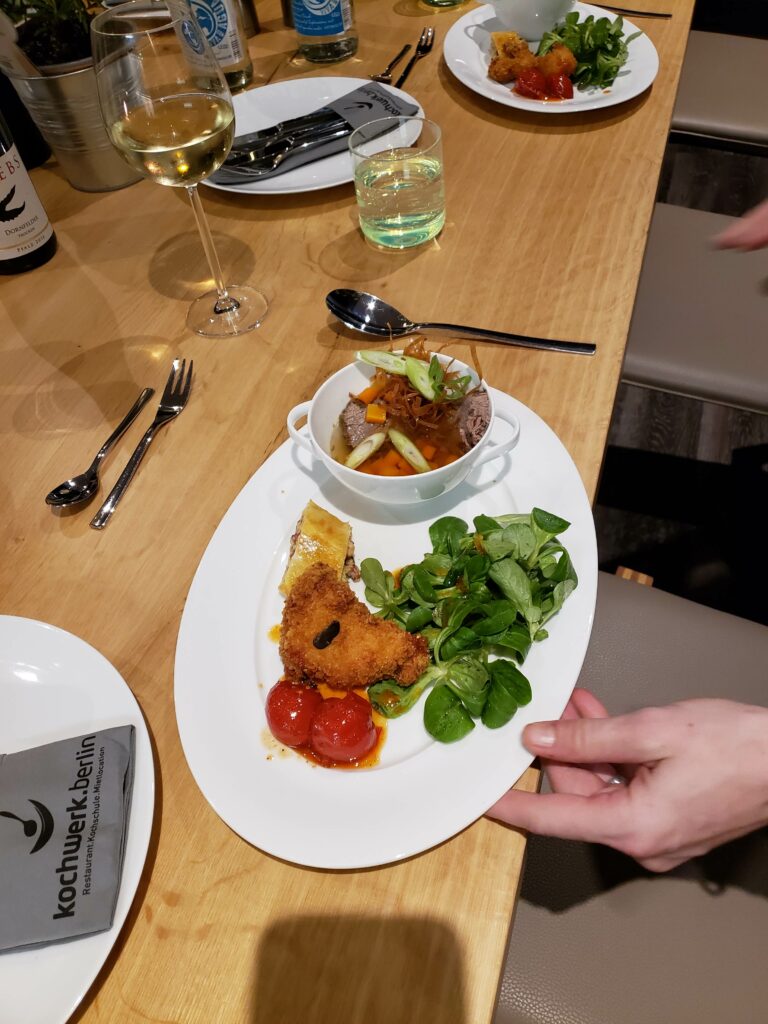
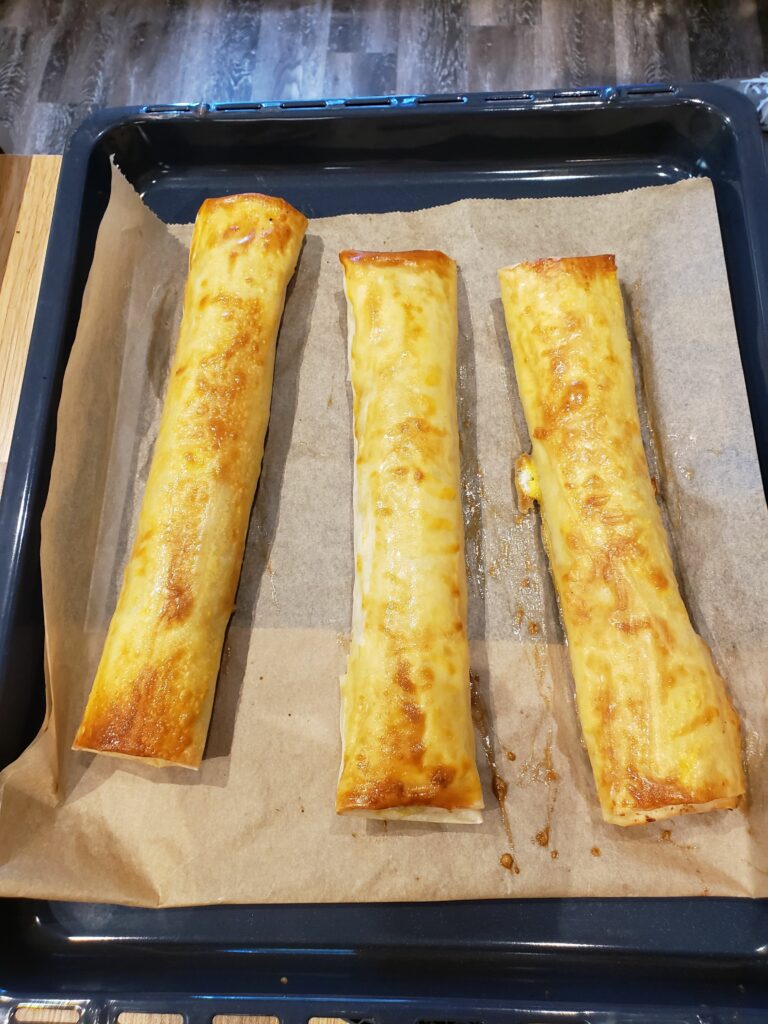
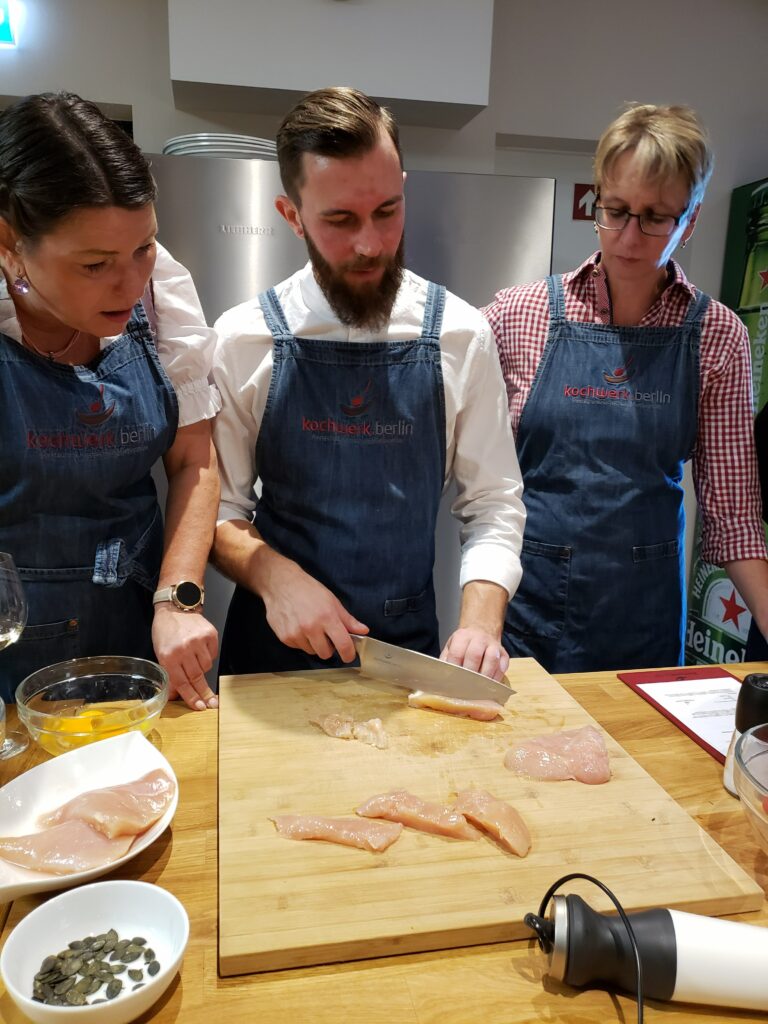
After this hearty beginning, there was veal done in the Zurich style (Zürcher Geschnetzeltes) with creamy mushroom sauce, crisp potato Rösti (like hash browns but oh-so-better), mushroom salad, and then the grande finale – Kaiserschmarren: a traditional and very delicious Austrian dish hybridding omelet and pancake served with prune plum compote and homemade pumpkin seed vanilla ice cream. Help!
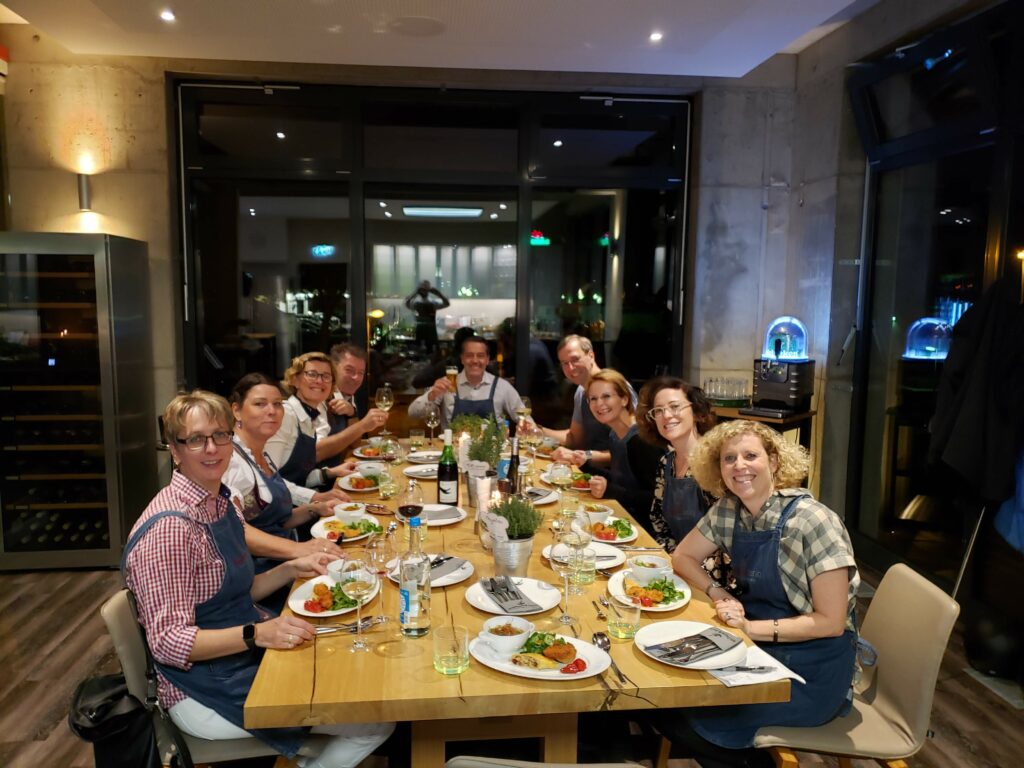
It was now well after 10pm, local brandy appeared from who knows where (pear, plum, apricot!) and thank goodness – espresso! Everyone had become fast friends and when I finally had to tear myself away at 11pm, there was much two-cheek kissing and hugging.
I stuffed myself in an Uber for the 40 minute ride back to the apartment. En route, I reminisced about the evening and again, how very much I felt like a local; this had me grinning big-time all the way back to Wilmersdorf.
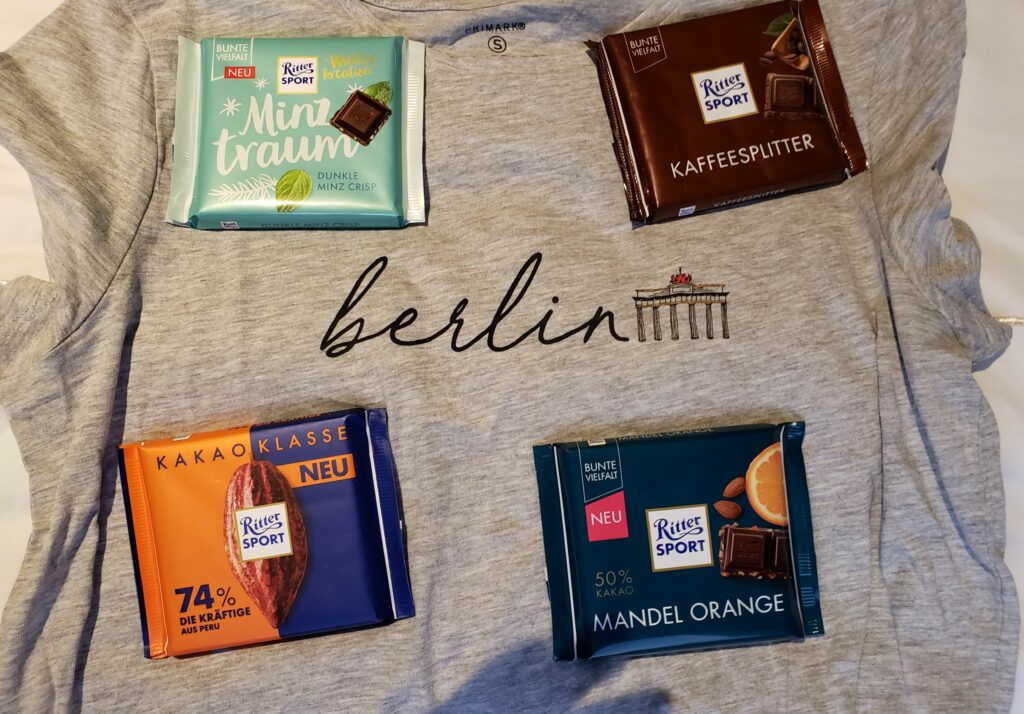
The next morning I bade farewell to Berlin and returned home…equipped with robust memories of delicious food, remarkable outings, and fade-proof experiences from a slice of Berlin which is perhaps off the beaten tourist path, but just perfect for me.
So what about the recipe? Much as I would love to share how I make Rote Grütze, we are completely out of season for that one. The whole point of the Grütze is to showcase summer’s freshest berries and cherries and red currants, bursting with flavor. I can, however, give you a glimpse into my pot of Rote Grütze from last August.
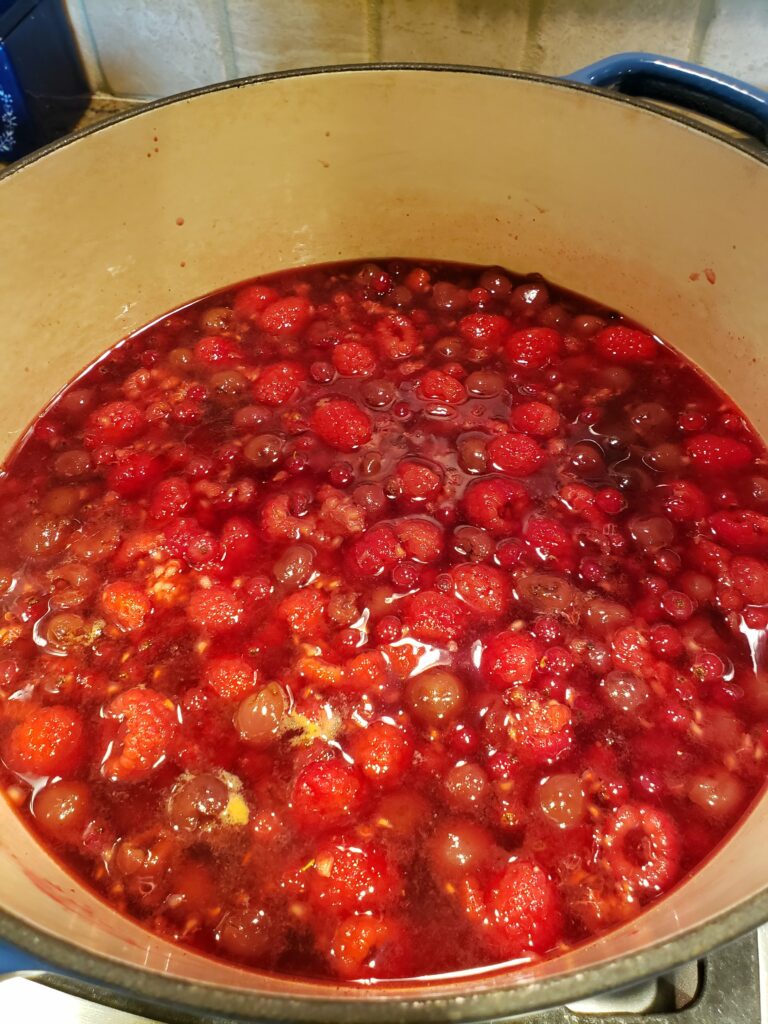
One of my favorite Berlin treats is Kranzkuchen, studded with nuts and marzipan filling, but it’s labor-intensive and gets stale rather quickly. Not the best choice for us to make.
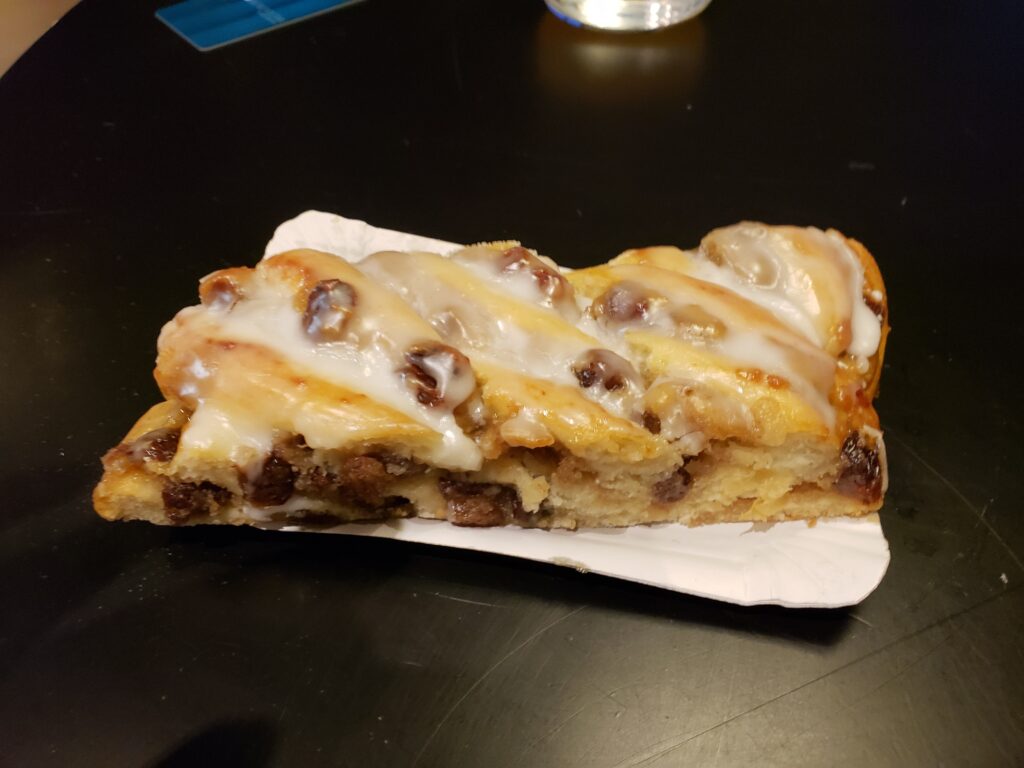
Instead, we’re going with my memory of the very first thing I recall eating and becoming enchanted by in Berlin, 45 years ago. That was Streuselkuchen (pronounced “schtroy-zel”), a yeast-driven buttery cake with a glorious sugary topping of multi-sized crumb-y streusel pieces. Like most pastries in Germany, it really ought to be eaten on the day it’s made and it’s a bit of a project, especially if you opt for the version with the crème filling. (YUM!) But I have a plan. We are going with a 2nd cousin of this kuchen – streusel jam bars or Prasselkuchen. Since it’s holiday time, these will be the perfect thing for you to have on hand to generously proffer to friends, neighbors, officemates, the mailperson, doorway carolers, etc, etc. You will find them exceedingly easy to nibble on alongside a cup of strong coffee or tea. My friend Karen says to try them with Earl Grey.
The recipe has been borrowed from my favorite source for all things German and sweet – Luisa Weiss’s Classic German Baking cookbook.
Prasselkuchen – makes 30 bars
Click here to view the recipe!
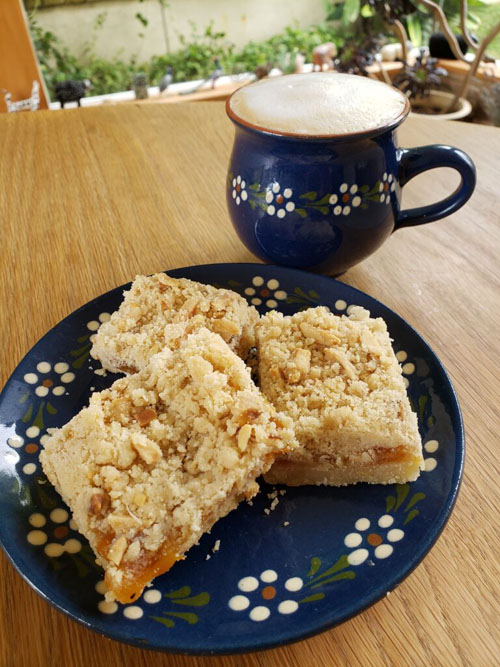
Mmmm……Lecker.

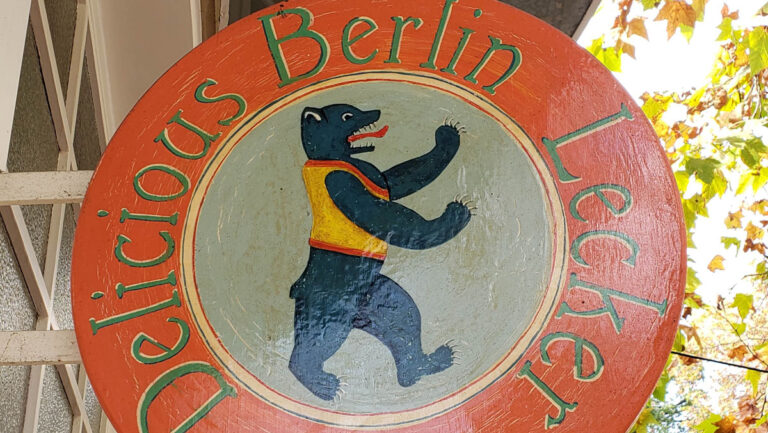
11 Comments
I always read your posts and then my stomach growls. You make everything sound SO delicious! So glad you had such a great time with your dad and loved reading your ‘local’ view of Berlin!
Awesome post!
was fur eine wundervolle zeit
Your German is getting so good! 🙂 Vielen Dank!
Dearest Girl remembering when I visited Berlin, one week before the wall came tumbling down. Thanks for this Blog brought back memories.
Thanks for writing and for sharing your memory. It was momentous being there 30 years after the fall of the wall. I think we ate an extra pastry or two to celebrate!
Yum! You’ve made Berlin come alive for us, Alysa. And the pressalkuchen (with coffee!) sounds divine. Trying to decide which jam to use —a delicious dilemma. Thanks for another great read, recipe and adventure. 🙂
Thanks for your note. I’m glad you got a chance to experience a bit of Berlin without the jetlag!
I could hear your voice and felt your energy as a read it. Thanks so much for sharing your passion
What a great read about Berlin. Thanks.
What a great post!